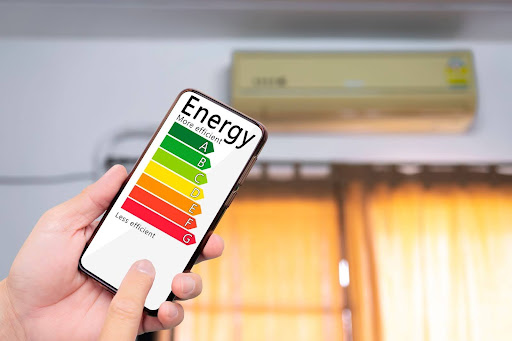These days, who isn’t looking to save money wherever they can? So, when it comes time to buy a new AC system, it’s only natural to want one that’s going to be easy on your wallet over the long haul.
Nobody wants to splash out on a system that ends up costing more in energy bills! Efficient Air Heating and Cooling, established in 1994, is here to guide you through the benefits of higher SEER ratings in air conditioning systems. As experts in heating, cooling, and indoor air quality services, we offer valuable insights to help you make informed decisions. Let’s dive into how a higher SEER rating can translate into savings for you.
What Is a SEER Rating?
SEER stands for Seasonal Energy Efficiency Ratio, a metric used to measure the energy efficiency of air conditioning systems. The SEER rating reflects the cooling output of an air conditioner over a typical cooling season, divided by the total electricity used to power it during the same period.
The higher the SEER rating, the more energy-efficient the air conditioner is. This means that air conditioners with a higher SEER rating use less energy to provide the same amount of cooling as units with a lower SEER rating.
Benefits of a Higher SEER Rating
You can unlock a world of benefits from energy-efficient air conditioning units. Some of the best benefits include:
Reduced Energy Costs
One of the most compelling reasons to opt for a high SEER system is the potential for reduced energy costs. Air conditioners and heat pumps with high-efficiency ratings are designed to minimize the energy required to achieve your desired indoor temperatures. Over the lifespan of the unit, this reduced energy consumption can lead to significant savings on your energy bills.
Imagine you have two air conditioners. One has a SEER rating of 10, and the other has a SEER rating of 20. Let’s say that over a typical cooling season, each unit needs to provide a total of 10,000 units of cooling.
- The air conditioner with a SEER rating of 10 would need 1,000 units of electricity to provide that cooling because 10,000 units of cooling ÷ 10 SEER = 1,000 units of electricity.
- The air conditioner with a SEER rating of 20, on the other hand, would only need 500 units of electricity to provide the same amount of cooling because 10,000 units of cooling ÷ 20 SEER = 500 units of electricity.
So, the air conditioner with the higher SEER rating uses half the electricity to achieve the same cooling effect, making it more energy-efficient and cost-effective in the long run.
Enhanced Comfort
Air conditioners with higher SEER ratings often come with advanced features that promote more consistent temperatures and better humidity control throughout your home or business. This means that not only do you save money, but you also enjoy a more comfortable living or working space.
Environmental Impact
Choosing a high-efficiency air conditioner or heat pump equals less energy consumption, which has a great positive impact on the environment. By reducing your total electric energy input, you’re also decreasing your carbon footprint, making a high SEER rating an eco-friendly choice.
Ductless HVAC Systems: An Efficient Alternative
For those looking to enhance their energy efficiency further, ductless mini-split HVAC systems offer an effective alternative. These systems provide targeted cooling and heating without the need for extensive ductwork, often resulting in a higher overall energy efficiency ratio.
SEER Ratings for Air Conditioners, Heat Pumps & Mini-Splits
The minimum SEER rating for air conditioners and heat pumps in the United States is set by the Department of Energy (DOE). These standards are part of federal efforts to improve energy efficiency and reduce environmental impact.
As of 2023, a more precise SEER2 rating for new air conditioners, heat pumps, and mini-split units varies by region due to differing climate demands. In the northern states, the minimum SEER2 rating is generally 14 for most air conditioning systems, while in the southern and southwestern states, where the climate is generally hotter, the minimum requirement is typically SEER2 15.
Choosing the Right SEER Rating for Your Needs
When considering an AC installation or replacement, it’s important to weigh the initial investment against the long-term savings. Systems with higher SEER ratings might cost more upfront but typically result in lower monthly energy bills. It’s a good idea to evaluate the typical cooling season in your area and your specific cooling needs to determine which SEER rating will offer the best balance of cost and efficiency.
Considerations for AC Installation
Proper installation plays a critical role in maximizing the efficiency of your new high SEER unit. Even the most energy-efficient air conditioners will underperform if they are not correctly sized and installed. A professional installation guarantees that your air conditioning unit operates at its optimal efficiency, providing maximum comfort and energy savings.
Contact Us Today for Help Selecting an Energy-Efficient Cooling System
At Efficient Air Heating and Cooling, we are committed to helping our clients achieve maximum comfort and efficiency. We’ve been serving the Owensboro, Kentucky, area since 1994, providing expert advice and emergency service.
If you’re ready to explore how a higher SEER rating can save you money, or if you have any questions about our services, please don’t hesitate to contact us. Let’s work together to find the perfect heating and cooling solution for your space.


Recent Comments